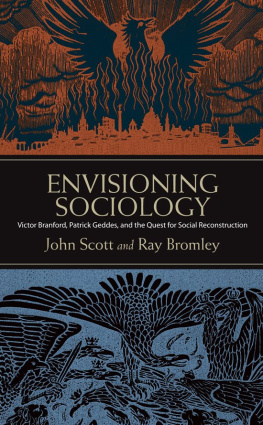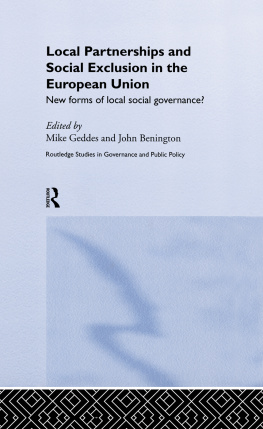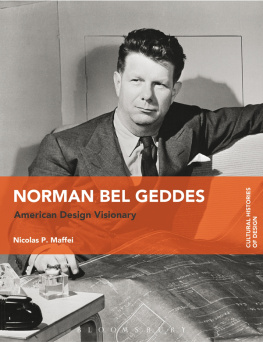ENVISIONING SOCIOLOGY
Victor Branford, Patrick Geddes, and the Quest for Social Reconstruction
JOHN SCOTT
RAY BROMLEY
STATE UNIVERSITY OF NEW YORK PRESS
The cover illustration is based on Armageddon (A.D. 191416), originally included in A Rustic View of War and Peace (). In its prefatory note, the anonymous author, almost certainly Victor Branford, describes the pamphlet as propaganda intended to change public opinion and to be diffused as widely as possible; not attributable to the Sociological Society. The illustration is unsigned, but attributed to Philip Mairet.
In the lower portion, the War Lords, under mask of their heraldic birds and beasts, are enjoying their Valhalla of combat seeking pillage, territory and imperial expansion. The combatants are nations and empires, monarchies and republics, represented by one- and two-headed eagles, winged and unwinged lions, a turkey, and a roostera panorama of Europe during World War I.
In the upper portion, the Phoenix rises from the burning citya city that is damaged, but still largely intact. Its skyline includes one major monument and numerous towers, spires, and domes associated with civic, religious, and educational institutions. Commerce and industry are arrayed around the civic core, peripheral rather than central to the great work of social reconstruction.
Published by
STATE UNIVERSITY OF NEW YORK PRESS, ALBANY
2013 State University of New York
All rights reserved
Printed in the United States of America
No part of this book may be used or reproduced in any manner whatsoever without written permission. No part of this book may be stored in a retrieval system or transmitted in any form or by any means including electronic, electrostatic, magnetic tape, mechanical, photocopying, recording, or otherwise without the prior permission in writing of the publisher.
For information, contact
State University of New York Press, Albany, NY
www.sunypress.edu
Production, Laurie Searl
Marketing, Anne M. Valentine
Library of Congress Cataloging-in-Publication Data
Scott, John, 1949
Envisioning sociology : Victor Branford, Patrick Geddes, and the quest for social reconstruction / John Scott and Ray Bromley.
p. cm.
Includes bibliographical references and index.
ISBN 978-1-4384-4731-5 (hbk. : alk. paper)
1. Branford, Victor. 2. Geddes, Patrick, Sir, 18541932. 3. SociologistsGreat BritainBiography. 4. SociologyGreat BritainHistory. I. Bromley, R. J. II. Title.
HM478.S38 2013
301.092'2dc23
[B]
2012027767
10 9 8 7 6 5 4 3 2 1
LIST OF TABLES

PREFACE AND ACKNOWLEDGMENTS

This book is the first to report on the sociological project of Victor Branford, Patrick Geddes, and their circle. While a number of biographies and discussions of Patrick Geddes have appeared, these concentrate on his work in urban planning. When considered within the wider social sciences he is often considered only as a planner or geographer, and not a sociologist. Mention of Victor Branford has been confined, at best, to the footnotes in histories of sociology, yet he was the leading organizational and intellectual figure in the early days of British sociology. The two stood at the heart of a vast international network of connections within the social sciences. Our book is predicated on the view that an assessment of their ideas and their practical work is long overdue.
The book has been a long time in preparation and many debts have been incurred during that time. John Scott's interest in the area was encouraged by a question raised by Sabita Branford, granddaughter of Victor Branford, at a meeting on British sociology at the London School of Economics. The project has also benefited from the discovery of family papers (now in the Keele University Archive) by Jean Branford, a distant relative of Branford's cousin who settled in South Africa. Much of the early research was undertaken jointly with Chris Husbands, who co-authored some early papers but was unable to continue to be involved in the project. We are immensely grateful to Chris for his continuing collaboration in our discussions. Ray Bromley's interest in the area stemmed from interest in Patrick Geddes's contributions to urban planning and from family connections close to Keele University.
Many archivists, family historians, and fellow social scientists have helped us track down obscure items of information. These are too numerous to name individually, but we have tried to indicate a number of these people in the endnotes of the book. We are grateful to all of them for making this book possible. The book is a true transatlantic and interdisciplinary cooperation, for both the authors and those who have helped us in our task. The two authors have met on a number of occasions but have pursued a largely electronic relationship for the best part of a decade. Each has undertaken library and archival research and the results have been shared for joint discussion and further development. It has been a hugely enjoyable and rewarding process.
The works discussed in the book are very much products of their time. This is especially apparent in the male-oriented language used and in what now seem rather archaic views of gender roles. While we have discussed the substantive biases and prejudices that appear in their work when discussing gender and women, we have not routinely noted or corrected the use of inappropriate pronouns. Despite this gender bias, it is striking that Branford and Geddes were among the few social scientists of their time who did actually regard the question of gender as a major topic for sociological discussion.
Victor Branford came from a large family and we have tried to ensure that the particular Branford we refer to in the text is always clear, either from the context or by explicit use of a first name. Biographical citations to Branford are always citations to Victor Branford, unless otherwise indicated, and other Branfords are distinguished by their initials where any doubt could arise. Where any confusion may arise, we cite Victor Branford as V. V. Branford. Citations to the work of Sybella Branford are made using the name under which she was published at the time, except that papers by Mrs. V. Branford are cited as S. Branford.
A great deal of biographical information has been acquired on the numerous individuals in and around the circle centered on Branford and Geddes. Material concerning the family members of the leading protagonists are included in the two appendices..
We hope that our readers will enjoy reading this book as much as we have enjoyed writing it.
John Scott, Cornwall, UK
Ray Bromley, Albany, N.Y., USA
June 2012
INTRODUCTION

British sociology has often been seen by commentators on the history of the discipline as the poor cousin of the intellectual developments that took place in other parts of the world. Long and thriving traditions of sociological analysis have been identified and much discussed in the United States, Germany, and France, and numerous social theorists and researchers in these countries have been seen as the architects of the classical sociologies that flowered from the late nineteenth century to the middle of the twentieth. A particularly influential commentator on intellectual culture has decried the absence in Britain of any classical sociology (). While Herbert Spencer has been recognized as a pioneering British sociologist and has had a substantial international impact, he has tended to be seen as having no lasting influence in his own country.













